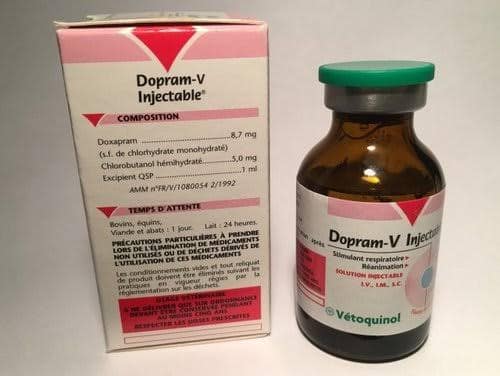Doxapram v Injection
Approved by the FDA, Doxapram v Injection is specifically designed for veterinary use. It is manufactured by Boehringer Ingelheim, a prominent name in the pharmaceutical industry.
Composition of Doxapram
The primary component of Doxapram is Doxapram hydrochloride, which accounts for 20 mg/ml of the solution. It also includes Benzyl alcohol as a preservative and Water for Injection, USP.
Description of Doxapram
Doxapram is a respiratory stimulant with a unique characteristic. It can stimulate respiration at dosages significantly lower than those required to evoke cerebral cortical stimulation. It has a marked arousal effect in anesthetized subjects, promoting the restoration of normal ventilation and producing early arousal following general anesthesia. This minimizes or prevents the undesirable effects of post-anesthetic respiratory depression or hypoventilation, thus hastening recovery.
Chemical Characteristics of Doxapram
The chemical name of Doxapram hydrochloride is 1-ethyl-4-(2-morpholinoethyl)-3,3-diphenyl-2-pyrrolidinone Hydrochloride Hydrate. It’s prepare as a clear, colorless, 2% aqueous solution with a pH of 3.5 to 5 and is stable at room temperature. The preservative used is Benzyl Alcohol, 0.9%, and sterilization is accomplish by aseptic filtration technique.
Species Variation and Doxapram
Different species of animals respond differently to Doxapram v Injection. For instance, dogs respond more dramatically to Doxapram than other species. On the other hand, the cat and rat showed comparatively less response.
Effect of Doxapram on Body Functions
Doxapram has shown to have significant effects on various body functions, including EEG, cerebral blood flow, and pituitary-adrenal axis. It stimulates the respiratory centers of the brain at low doses and stimulates other parts of the neuraxis at higher doses.
Doxapram’s Interaction with Other Drugs
Doxapram’s respiratory stimulant effects were not block by anesthetic doses of Phenobarbital Sodium, Pentobarbital Sodium, Thiopental Sodium, Secobarbital Sodium, Halothane and Methoxyflurane in dogs and cats. It stimulate respiration that was severely depressed with Morphine or Meperidine. However, it caused convulsions in cats, a species known to be convulsant in response to Morphine.
Dosage of Doxapram
The dosage of Doxapram v Injection should be adjust to meet the requirements of the situation. Excessive doses may lead to hyperventilation, which can result in respiratory alkalosis.
Dosage for Dogs and Cats
For dogs and cats under barbiturate anesthesia, the recommended dosage is between 1/8 mL (2.5 mg) to 1/4 mL (5 mg) per lb body weight. For those under gas anesthesia, the recommended dosage is 1/40 mL (0.5 mg) per lb body weight.
Dosage for Horses
For horses under different types of anesthesia, the dosage varies. For instance, under Chloral hydrate, Chloral hydrate and magnesium sulfate barbiturates, the recommended dosage is 0.0125 mL (0.25 mg) per lb body weight. Under inhalation anesthesia halothane, methoxyflurane, the recommended dosage is 0.01 mL (0.20 mg) per lb body weight.
Dosage for Neonate Canine and Feline
For neonate dogs and cats suffering respiratory crisis following dystocia or caesarean section, Doxapram can be administer either subcutaneously, sublingually (topically), or via the umbilical vein in doses of 1-5 drops (1-5 mg) depending on the size of the neonate and the degree of the respiratory crisis.
Caution for Doxapram Usage
It’s important to note that Doxapram is not an antagonist of muscle relaxant drugs nor a specific narcotic antagonist. Doses should be adjust to meet the requirements of the situation.
How to Store Doxapram
Doxapram should be store at a controll room temperature between 15 – 30°C (59 – 86°F).
Conclusion
Doxapram v Injection is a potent respiratory stimulant with a unique ability to stimulate respiration at doses considerably lower than those required for cerebral cortical stimulation. Understanding its composition, uses, and dosage is crucial for its effective and safe use in the veterinary field.





Reviews
There are no reviews yet.